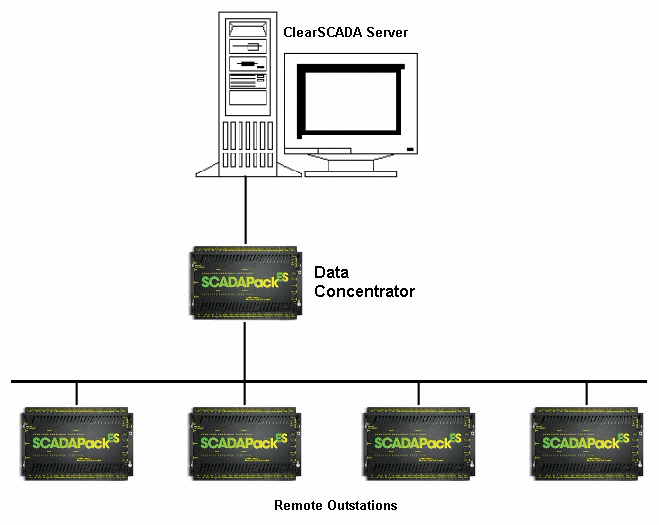SCADAPack E outstations are able to act as ‘data concentrators’ and retrieve data from other outstations—known as ‘remote’ outstations—using the DNP3 protocol. The data concentrators are the ‘parent’ outstations of the remote outstations.
With the DNP3 SCADAPack E driver, any supported SCADAPack E outstations that are able to act as data concentrators can be configured as parent outstations.
With a parent-remote setup, either:
- A data concentrator can scan all of its remote outstations for data, then process that data before passing the relevant information onto ClearSCADA. (Only a SCADAPack E outstation that is appropriately licensed can provide such data concentrator functionality.)
If communications with the ClearSCADA server is temporarily lost, the data concentrator can continue to poll its remote outstations.
- ClearSCADA can scan the remote outstations itself, with communications going ‘transparently’ via the remote outstations’ parent outstation
- A data concentrator can scan its remote outstations for some point data, with ClearSCADA scanning the same remote outstations ‘directly’ for other point data. If required, both the data concentrator and ClearSCADA can scan the same point(s) on a remote outstation.
In each of the above scenarios, a remote outstation can be a SCADAPack E outstation, or another device that communicates using the DNP3 protocol.
A ClearSCADA system might be configured to use a parent-remote set-up if, for example, there were limited communications to a site. By using a parent outstation, ClearSCADA could obtain the data from multiple remote outstations via just the one radio or dial-up modem connection to each parent outstation. Similarly, a parent-remote set-up might be used to enable a parent outstation to contain the logic and other programming that is required for its remote outstations.
Example:

With a parent-remote setup, within ClearSCADA you need to configure a DNP3 SCADAPack E Outstation of the appropriate type (Direct, PSTN, or Shared) for each parent outstation, along with the appropriate DNP3 Channel(s) and DNP3 Outstation Set(s).
You also need to configure a DNP3 SCADAPack Remote E Outstation for each remote SCADAPack E outstation (or a DNP3 SCADAPack Remote DNP3 Device for each remote third-party or non-E outstation).
You need to configure a DNP3 SCADAPack point for each point that ClearSCADA is to monitor or control on each parent outstation and remote outstation. (This includes points on remote outstations that are not SCADAPack E outstations, if the parent outstations are to scan those remote outstations for data.)
If the parent outstations are to scan the remote outstations for data, those parent outstations need to include blocks of internal Derived (User) points that enable them to control and monitor the status of the remote outstations (see Configure Common Properties of DNP3 SCADAPack Points and see Configure the Data Concentrator Status and Control Points).
If ClearSCADA is to scan the remote outstations ‘transparently’ via their parent outstation, you will need to configure a DNP3 Routing Table to specify how the remote outstations are connected to the parent outstation (see Route DNP3 Frames Using a DNP Route Table). If communications between the parent outstation and the remotes is via an Ethernet connection, an IP Route Table will be required (see Use an IP Route Table to Route TCP/IP Packets to Another TCP/IP Host). (If the remote outstations are not SCADAPack E outstations and ClearSCADA is to scan those outstations ‘transparently’ via their parent outstation, you will need to configure a DNP3 point for each point on those remote outstations, rather than a DNP3 SCADAPack point.)
The outstation with which you associate each point on a remote outstation varies, depending whether the point is scanned by a data concentrator and/or ClearSCADA (see With Which Database Item do I Associate each DNP3 SCADAPack Point?).
Further Information
Configuring DNP3 SCADAPack E Outstations.
Configure Data Concentrator Properties.
Specify the Remote DNP3 Device Properties.
Points Used on DNP3 SCADAPack E Outstations.
See the ClearSCADA Guide to the DNP3 Driver for information about configuring DNP3 Channels, Outstation Sets, non-SCADAPack E outstations and DNP3 points.